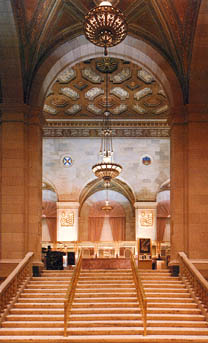
Serving Canadians Since 1869
 |
Royal
Bank of Canada
Serving Canadians Since 1869 |
The Royal Bank story begins in 1869, a signal year in the annals of human progress. It was a time when our forebears were laying the foundations of the modern world with new ideas, new inventions and new enterprises.

In Halifax, the founders of the bank got their charter in the name of the Merchants Bank of Halifax. It had evolved out of the “upstart” unincorporated Merchants Bank, which had opened in 1864 as a private partnership offering short-term credit to traders in the bustling international port. Its seven promoters included a member of the Cunard family whose graceful new steamships originated there.
The vessels of Cunard and other lines opened up frontiers for the young bank east across the Atlantic and deep into the Caribbean. To the west, the emerging railways rapidly opened the seemingly endless frontiers of the new nation called Canada.
Almost from day one, the bank struck out boldly, and sometimes at great risk, into the hinterland, to beat the competition in pursuing opportunities along the arteries of developing trade. Its daring vault across the continent to British Columbia as the century closed is an example of this powerful drive to develop new areas.
In this spirit of reaching for new horizons, in 1907, chief executive Edson Pease, the visionary titan of Royal Bank’s history, orchestrated the move of the bank’s head office from Halifax to Montreal’s bustling Rue St. Jacques, then Canada’s undisputed financial capital.
By 1910 the bank had conquered many geographical frontiers. It had grown with Canada into a national institution, the Royal Bank of Canada. It had branches from coast to coast and was starting to build a foreign reach that would give it global distinction.
 What
lay ahead was a different frontier — a frontier opened by the necessary
restructuring of the Canadian banking system. While many banks were unequal
to this task, Royal Bank was a winner. Through a series of insightful mergers,
culminating with the Union Bank of Canada in 1925, it became the industry
leader. This strategy of building its business is still firmly in place.
Most recently, the acquisitions of Dominion Securities and Royal Trust
have added enormous strength to the Royal Bank group by expanding and diversifying
its reach and revenue at home and abroad.
What
lay ahead was a different frontier — a frontier opened by the necessary
restructuring of the Canadian banking system. While many banks were unequal
to this task, Royal Bank was a winner. Through a series of insightful mergers,
culminating with the Union Bank of Canada in 1925, it became the industry
leader. This strategy of building its business is still firmly in place.
Most recently, the acquisitions of Dominion Securities and Royal Trust
have added enormous strength to the Royal Bank group by expanding and diversifying
its reach and revenue at home and abroad.
To have prospered, and to have been Canada’s leading financial institution for so long, is quite an achievement. But the challenge that lies ahead, says Royal Bank Chairman and CEO Allan Taylor, is to maintain this envied status as the bank reaches for new frontiers.
As Dr. Duncan McDowell says in his recent history of the Royal Bank called Quick to the Frontier, if there are heroes in the chronicles of Royal Bank, they are the men and women who mastered the art of what one turn-of-the-century banker called “cautionary boldness.” It is a quality that has long been a hallmark of Royal Bank people and one that will serve the bank well as it prepares for the 21st Century.